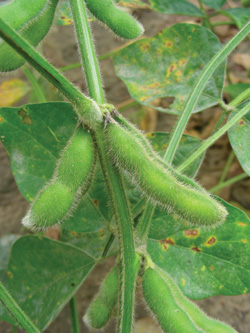
Features
Agronomy
Genetics/Traits
Taking a ‘lead’ on resistance
Aphids reveal much in their choices.
November 13, 2007 By Ralph Pearce
 As the end of the 2005 growing season approached, many agronomists and extension
As the end of the 2005 growing season approached, many agronomists and extension
personnel in Ontario raised the flag on soybean aphids. The general consensus
was that given the pest's overwintering capability, growers could expect to
see aphids every year, not every other year, as the perception suggested.
Just prior to the 2005 growing season, Pioneer Hi-Bred held a series of grower
information sessions across the province. At one such gathering, Dr. John Soper,
Pioneer's director of soybean research, spoke of a relatively new project that
would help in the fight to control aphids. In very simplistic terms, the research
calls for wire leads to be connected to the aphids to measure changes in an
electrical current passing through them as they feed on soybean leaves. The
device, called an Electrical Penetration Graph (EPG), measures both electromotive
force (EMF) and resistance.
Dr. John Reese, a professor of entomology with Kansas State University in Manhattan,
Kansas, has been studying aphid feeding behaviour since the 1980s. Using EPG
technology, Reese found changes in electrical impulses as aphids insert their
stylets between cells, looking for a sieve element, a key structure in a soybean
leaf's vascular bundle. It is the sap inside the bundle that aphids want. "But
on their way to that sieve element, they periodically puncture a cell, and each
time they puncture the cell, there's a potential drop in recorded electrical
impulse," says Reese. Since the voltage is lower inside a plant cell than
outside, the monitor on the EPG unit records a significant drop in readings.
"Every time you see one of those, you know it punctured that cell, spit
a little something into that cell and sucked a little bit out of that cell."
Reese has seen some unique virus acquisition and inoculation experiments which
demonstrate what is really happening along this route.
Once the aphid works its way down to the sieve element, the monitor indicates
a sustained feeding period that can last hours and possibly days in susceptible
plants. But on resistant plants, the aphid may have some degree of difficulty
in getting to the sieve element or something may happen to convince the pest
to move on. "The EPG technique is a fantastic way to see, in detail, exactly
where in this normal sequence of events, the resistant plant is different from
the susceptible plant," says Reese. "There's a lot of detail on where
and how the aphid is feeding."
A lot of what, just no 'why'… yet
What the research tells Reese is that developing resistance is feasible, even
in a rudimentary form. Various things can happen as the aphid probes for the
sieve element and as the EPG monitors that, it gives researchers a guide to
conferring that to a soybean variety. In this case, the 'what' or the resistance
to the soybean is recognized without being clearly understood. The good news
is that there is a method by which some form of resistance can be conferred.
"You could conceivably monitor a plant and get a preliminary idea, not
a very good statistical design," says Reese. "But it would be a rough
idea of the resistance level of that plant and allow you to put it back in the
greenhouse and get seeds from it."
The next step in the process is to begin the mapping and crossing for the compound
or compounds involved, or whether there is a structural component involved.
That, notes Reese, can take years to determine. "With an aphid, you don't
grind up the whole plant because the aphid is not being subjected to the whole
plant," he says, adding that it is significantly different from determining
resistance criteria for a caterpillar. "The things that may be contributing
to differences in feeding behaviour could conceivably be associated with many
different genes. The technology to analyze just from chemistry is not trivial."
Private sector joining in, as well
From a private sector perspective, Soper is very upbeat about the potential
for Reese's work, especially in light of emerging challenges dealing with thresholds
and severe infestations. "If we can identify one or several good sources
of resistance, it gives us an opportunity to provide a new level of aphid tolerance
for growers," says Soper, who is based in Johnston, Iowa. "Through
those techniques, Reese can start to make and test hypotheses about the actual
modes of resistance. Possibilities include leaf surface characteristics that
cause irritability for the aphid to interrupt aphid probing, and changes in
the leaf structure that prevent the aphids from penetrating the sieve element
cells. Or it might be a chemical response of the plant that deters feeding or
reduce the survival and reproductive capacity of the aphids."
The hope is to sort through some of those different mechanisms. If Reese is
successful, it will enable researchers like Soper to combine different genetic
sources of resistance in commercial varieties. From the Pioneer perspective,
Soper acknowledges that they have identified a few sources of resistance and
are beginning to confer them to soybean lines. "Yes, it's without knowing
exactly what type of resistance we have, but we know it works and have sufficient
information for our plant breeders to begin making crosses and developing resistant
varieties," explains Soper. "We hope to have varieties with much improved
levels of tolerance or resistance over current values on the market by 2009
or 2010."
His work with Reese will continue, as they try to identify additional sources
of resistance and to determine if they are unique or the same compared to what
the aphid does on the plants. As well, Pioneer is trying to identify the genes
that control aphid resistance from different sources. The goal is to identify
their locations on soybean chromosomes and combine multiple sources of resistance
into commercially available varieties. -30-